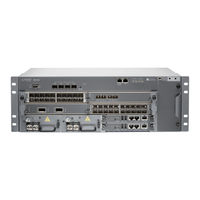
Juniper MX104 Manuals
Manuals and User Guides for Juniper MX104. We have 3 Juniper MX104 manuals available for free PDF download: Hardware Manual, Quick Start Manual
Juniper MX104 Hardware Manual (282 pages)
3D Universal Edge Router
Brand: Juniper
|
Category: Network Router
|
Size: 6.73 MB
Table of Contents
Advertisement
Juniper MX104 Hardware Manual (214 pages)
3D Universal Edge Router
Brand: Juniper
|
Category: Network Router
|
Size: 6.44 MB
Table of Contents
-
-
-
-
Router53
-
-
-
-
-
-
-
-
-
Appendixes129
-
-
-
-
-
Canada165
-
Israel166
-
Japan167
-
United States167
-
-
-
Router173
-
-
-
-
-
Pinouts195
-
Juniper MX104 Quick Start Manual (30 pages)
niversal Routing Platforms
Brand: Juniper
|
Category: Network Hardware
|
Size: 1.79 MB
Table of Contents
Advertisement
Advertisement


